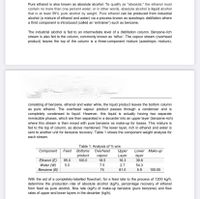
Introduction to Chemical Engineering Thermodynamics
8th Edition
ISBN: 9781259696527
Author: J.M. Smith Termodinamica en ingenieria quimica, Hendrick C Van Ness, Michael Abbott, Mark Swihart
Publisher: McGraw-Hill Education
expand_more
expand_more
format_list_bulleted
Question
need the correct ans

Transcribed Image Text:Pure ethanol is also known as absolute alcohol. To qualify as "absolute," the ethanol must
contain no more than one percent water, or in other words, absolute alcohol is liquid alcohol
that is at least 99% pure alcohol by weight. Pure ethanol can be produced from industrial
alcohol (a mixture of ethanol and water) via a process known as azeotropic distillation where
a third component is introduced (called an 'entrainer') such as benzene.
The industrial alcohol is fed to an intermediate level of a distillation column. Benzene-rich
stream is also fed to the column, commonly known as 'reflux'. The vapour stream (overhead
product) leaves the top of the column is a three-component mixture (azeotropic mixture),
consisting of benzene, ethanol and water while, the liquid product leaves the bottom column
as pure ethanol. The overhead vapour product passes through a condenser and is
completely condensed to liquid. However, this liquid is actually having two separate
immiscible phases, which are then separated in a decanter into an upper layer (benzene-rich)
where this stream is then mixed with pure benzene as make-up for losses. This mixture is
fed to the top of column, as above mentioned. The lower layer, rich in ethanol and water is
sent to another unit for benzene recovery. Table 1 shows the component weight analysis for
each stream.
Table 1: Analysis of % w/w
Upper
Layer
Component
Lower Make-up
Feed Bottoms
product
Overhead
vapour
layer
Ethanol (E)
Water (W)
Benzene (B)
95.0
100.0
18.5
16.3
39.8
5.0
7.5
2.7
54.3
74
81.0
5.9
100.00
With the aid of a completely-labelled flowchart, for a feed rate to the process of 1200 kg/h,
determine the production rate of absolute alcohol (kg/h), percentage recovery of ethanol
from feed as pure alcohol, flow rate (kg/h) of make-up benzene (pure benzene) and flow
rates of upper and lower layers in the decanter (kg/h).
Expert Solution
This question has been solved!
Explore an expertly crafted, step-by-step solution for a thorough understanding of key concepts.
Step by stepSolved in 6 steps with 2 images

Knowledge Booster
Similar questions
- What is meant by turndown ratio?arrow_forwardIn scanning electron microscope SEM, light is sent to the sample in order to get different signals and data from the sample. A) Doğru B Yanlışarrow_forwardCompose a problem about Material balance with chemical reaction including 3 unit process with recycling. Give at least 3 questions. With Solutions. THANKSarrow_forward
- write a note on 2 Dimensional Defects(All of them), Electron Microscope(TEM, SEM, STM) support your writing with picturesarrow_forwardWhat is the best method for estimating the distribution of nonkey components at the actual (operating) reflux?arrow_forward2. A 1 L, 100 g (dry weight) sample is removed from a continuous crystallizer which is operated with a residence time of 1000 s. The following particle size distribution is obtained for the sample: i) Size range (um) Mass (g) 200- 300- 400 500 600-700- 800- 300 400 500 600 700 800 900 0- 100- 100 200 2.5 26.0 30.0 21.0 12.0 6.0 2.0 0.5 0.0 Microscopy based on the sieve fractions has found that a volumetric shape correction factor, ky, of 0.52, for the crystal population and the crystal density has been found to be 2000 kg/m³ Determine whether the MSMPR model describes the system. If it does so, then determine the growth and nucleation rates for this system; if it does not, suggest why reasons that may cause deviation of this CSTR type crystallizer from the MSMPR model.arrow_forward
arrow_back_ios
SEE MORE QUESTIONS
arrow_forward_ios
Recommended textbooks for you
 Introduction to Chemical Engineering Thermodynami...Chemical EngineeringISBN:9781259696527Author:J.M. Smith Termodinamica en ingenieria quimica, Hendrick C Van Ness, Michael Abbott, Mark SwihartPublisher:McGraw-Hill Education
Introduction to Chemical Engineering Thermodynami...Chemical EngineeringISBN:9781259696527Author:J.M. Smith Termodinamica en ingenieria quimica, Hendrick C Van Ness, Michael Abbott, Mark SwihartPublisher:McGraw-Hill Education Elementary Principles of Chemical Processes, Bind...Chemical EngineeringISBN:9781118431221Author:Richard M. Felder, Ronald W. Rousseau, Lisa G. BullardPublisher:WILEY
Elementary Principles of Chemical Processes, Bind...Chemical EngineeringISBN:9781118431221Author:Richard M. Felder, Ronald W. Rousseau, Lisa G. BullardPublisher:WILEY Elements of Chemical Reaction Engineering (5th Ed...Chemical EngineeringISBN:9780133887518Author:H. Scott FoglerPublisher:Prentice Hall
Elements of Chemical Reaction Engineering (5th Ed...Chemical EngineeringISBN:9780133887518Author:H. Scott FoglerPublisher:Prentice Hall
 Industrial Plastics: Theory and ApplicationsChemical EngineeringISBN:9781285061238Author:Lokensgard, ErikPublisher:Delmar Cengage Learning
Industrial Plastics: Theory and ApplicationsChemical EngineeringISBN:9781285061238Author:Lokensgard, ErikPublisher:Delmar Cengage Learning Unit Operations of Chemical EngineeringChemical EngineeringISBN:9780072848236Author:Warren McCabe, Julian C. Smith, Peter HarriottPublisher:McGraw-Hill Companies, The
Unit Operations of Chemical EngineeringChemical EngineeringISBN:9780072848236Author:Warren McCabe, Julian C. Smith, Peter HarriottPublisher:McGraw-Hill Companies, The

Introduction to Chemical Engineering Thermodynami...
Chemical Engineering
ISBN:9781259696527
Author:J.M. Smith Termodinamica en ingenieria quimica, Hendrick C Van Ness, Michael Abbott, Mark Swihart
Publisher:McGraw-Hill Education

Elementary Principles of Chemical Processes, Bind...
Chemical Engineering
ISBN:9781118431221
Author:Richard M. Felder, Ronald W. Rousseau, Lisa G. Bullard
Publisher:WILEY

Elements of Chemical Reaction Engineering (5th Ed...
Chemical Engineering
ISBN:9780133887518
Author:H. Scott Fogler
Publisher:Prentice Hall


Industrial Plastics: Theory and Applications
Chemical Engineering
ISBN:9781285061238
Author:Lokensgard, Erik
Publisher:Delmar Cengage Learning

Unit Operations of Chemical Engineering
Chemical Engineering
ISBN:9780072848236
Author:Warren McCabe, Julian C. Smith, Peter Harriott
Publisher:McGraw-Hill Companies, The